Seventh Annual Waste360/Stifel Investor Summit Puts People First
Here are some of the key highlights from the 2019 Waste360/Stifel Investor Summit at WasteExpo.

WasteExpo 2019 officially kicked off with the seventh annual Waste360/Stifel Investor Summit on May 6, and “putting people first” was a dominant theme throughout the full-day summit.
Safety and employee retention were two of the biggest topics discussed during a series of one-on-one conversations and panel discussions that Michael E. Hoffman, managing director and group head of Diversified Industrials at Stifel, had with some of the most recognizable names in the waste and recycling industry, including Jim Fish, CEO of Houston-based Waste Management (WM).
During a one-on-one conversation with Fish, Hoffman kicked off the discussion by pointing out Fish’s 18-year tenure in the industry. Regarding some of the changes he’s seen in the industry during his tenure, Fish explained he has seen changes across the business in both labor and recycling, but there hasn’t been a major disrupter—someone like Jeff Bezos, Amazon founder and CEO, for instance—to come in and shake up the entire space.
The conversation then turned to the heart of Waste Management’s operations under Fish: putting people first.
"I want people to say 'Jim made this a great place to work,'" Fish said of what he wants his legacy to be in the industry. “It’s a very familiar industry. In every company sitting in the room here and that does business in this space, it feels very much like a family business. By extension, I would say that every one of those companies puts their people first.”
When asked how data and what key performance indicators (KPIs) influence Waste Management’s business operations, particularly related to company culture, Fish said the company tracks employee turnover statistics, but emphasized that overall culture is much more than driver or technician retention.
“Culture is really about are people excited coming to work? Do they feel like they’re making a difference? I think culture is kind of ill-defined at times, and people don’t really know what it is. [It's] kind of like ‘sustainability,’ where people don’t really actually know what the word means,” he noted. “Since culture is difficult to define, it is difficult to measure. But there is a gut feel in me that says if I can make people feel like they’re making a difference, make them feel valuable and like they have a voice, then I think that at least solves some of our cultural issues that we’ve had as a company in the past.”
When it comes to technology and innovation in the industry, Fish alluded to the fact that the industry has been slow to adopt certain technologies, but he feels the industry is making strides and does a better job of “focusing on our people” better than other industries.
Hoffman then asked: “What can this industry do to set the stage around labor and immigration? What is an opportunity set here?”
Fish said politicians on both sides need to get it together when it comes to immigration, adding that 24 percent of the waste and recycling industry is made up of Hispanics. “Washington cannot get its act together on immigration—no matter what party is in the White House,” he said.
Regarding the industry’s role in taking the lead on vocational training and promoting a viable career path for the incoming workforce, Fish explained that there is a perception issue across all industries—not just waste and recycling—when it comes to trade jobs. A lot of people coming out of college today are having trouble finding jobs, but that’s not the case with vocational positions where there is always a need.
“Part of our responsibility is to educate folks on how good these positions are and not make them look like they’re second-class citizens but, in fact, that these are really good jobs,” added Fish.
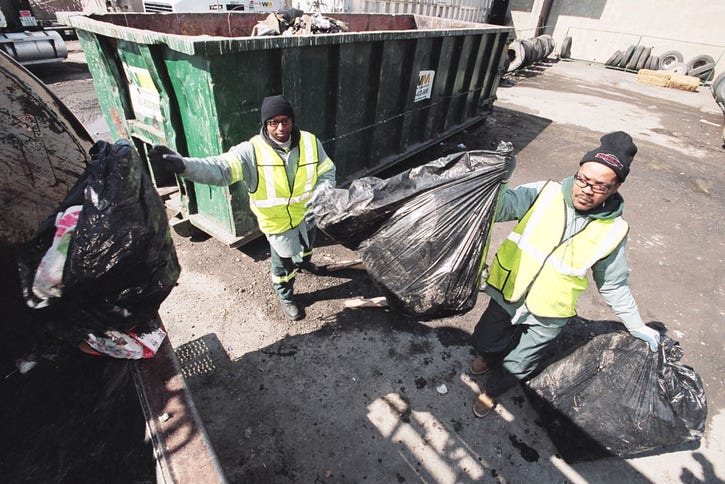
And when it comes to electrification, automation and fully autonomous (Level 5) vehicles, Fish said that although he doesn’t believe electric vehicles (EV) will be the ubiquitous vehicles of the waste and recycling industry anytime soon, growth is still significant.
“[EV] growth is significant, but it’s not going to surpass gasoline vehicles in my lifetime,” noted Fish, adding that WM’s migration to natural gas vehicles has been less expensive for the company to maintain.
Regarding safety and the industry constantly listed among the top five most dangerous occupations in North America, Fish said the industry makes this list every year because haulers interact with the general public every day.
“We’ve had four employees over the last two years killed by distracted drivers,” said Fish. “Part of this has to be an education process, and there needs to be stricter laws on distracted driving.”
Over the past seven years that Stifel and Waste360 have held the Investor Summit, Hoffman said he routinely asks industry stakeholders what challenges they would like addressed during the session. This year, the response Hoffman received was overwhelmingly tied to the industrywide labor shortage and municipal recycling contracts.
Here are some additional highlights from this year’s Investor Summit:
Waste Connections Talks Labor Shortage, WM/Advanced Disposal Acquisition
Waste Connections President Worthing F. Jackman and Chief Financial Officer (CFO) Mary Anne Whitney emphasized the company’s focus on “servant leadership,” which is to make frontline employees the focus with all management efforts toward helping the operators do their jobs better and safer. That includes holding town hall meetings to stay in touch with the frontline employees on topics like employee engagement and technology applications for customer engagement.
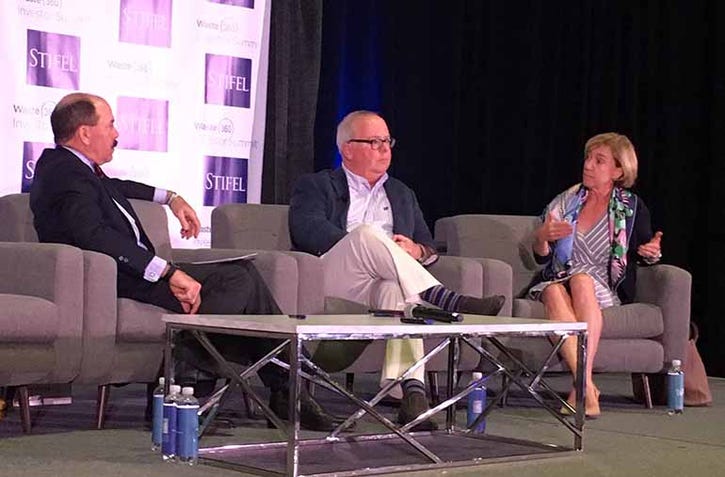
“Relationships drive results, and you can either have a purposeful culture or accidental culture,” stressed Jackman. “We decided over a decade ago that our culture will be purposeful. We had to pursue something called servant leadership, which I think people have heard about. Really, it’s putting us on the bottom and our frontline employees on the top and that everything we do is to help our employees and their lives both at work and outside of work.”
“If we can do that right, we can marry that with a commitment-based approach to safety, we can drive turnover down because retention is going up,” he added. “You can drive the frequency of incidents down. Investing in human capital to us is what distinguishes a company long term. And I think everyone else in this room would embrace that theory.”
Over the last three years, Jackman said the company expanded from 7,000 employees to 18,000, and that it’s an ongoing effort to maintain the “servant leadership” mindset.
In a tight labor market, Waste Connections management spends roughly 80 to 85 percent of its time on the people aspect of the business. Jackman and Whitney noted that the company has doubled the number of in-house recruiters and a focus on promoting from within the company.
“You do whatever you can to continue to attract new people,” emphasized Jackman. “It’s a challenge for our industry, particularly with frontline drivers and mechanics—that’s where this industry is struggling.”
Hoffman then turned the focus to the company’s perception of the U.S. economy. Jackman said the economy remains “slow and steady,” making it a nice environment to operate in. Jackman and Whitney added that Waste Connections does not see a “bubble building” with the slow and steady activity continuing with incrementally better waste volumes and strong pricing, which highlight economic stability.
Regarding acquisition activity, Whitney said the company sees the deal market acquired annual revenue opportunity to be in the $3.5 billion to $4 billion range with the timing of deals to be continued to be driven by sellers deciding to come to market. Hoffman also pointed to some saying Waste Connections was at one point considering the purchase of Advanced Disposal Systems (ADS).
When Hoffman asked about potential opportunities regarding Waste Management’s acquisition of ADS, Jackman noted that Waste Connections sees divestitures out of the WM/ADS deal as an incremental opportunity that were not in previous acquisition expectations for 2020.
“It’ll be an opportunity for a lot of companies,” he added. “It’s still kind of an unknown right now as to what will be presented.”
Attracting Millennials, Gen Y and Gen Z to the Industry
Over the seven years of the Investor Summit, Hoffman noted that he reaches out to several service companies and asks about the hot topics people want to hear during the summit, and labor challenges remain at the forefront of industrywide concerns.
The first panel of the summit was a discussion on how business can recruit and retain Generation Y (Gen Y) and Generation Z (Gen Z) into industrial service segment. Panelists Dr. Denise Villa, GenHQ co-founder and president, and Tamla Oates-Forney, Waste Management chief of human resources, defined the generations, provided tips on how to recruit and retain a multigenerational workforce and debunked some of the myths surrounding those generations.
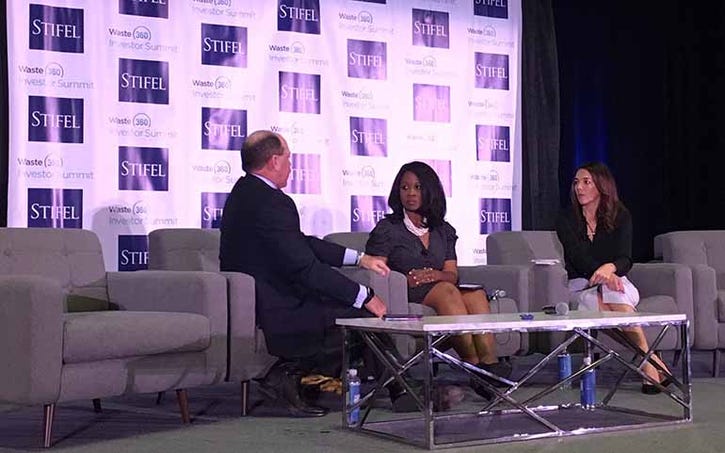
Millennials age range is 23 to 41 years. Millennial group can be further broken down into the “Me” group and “Mega” group, with the “Mega” seeing more career/life goal achievement, noted Villa. Gen Z is up to 23 years of age.
“Millennials and Gen Z are different,” explained Villa. “We are not seeing Gen Z as millennials 2.0. They are still young and just starting to come in, so we are continuing to study them.”
Regardless of the generation, employees want to be valued and have stability. In order to attract more talent to the industry, there needs to be a shift in the narrative that college is necessary, but that potential employees can have a successful career with a focus on skills development that can be fulfilling and provide future opportunities, noted Villa.
Oates-Forney noted that in order to recruit workers from Gen Z, companies must change the way they work, how they recruit people and the manner in which they design the benefits of a job.
“We have to reach this generation early on to talk about careers in this industry,” she explained, adding that could mean as early as middle school. “Once you create an awareness and get them interested, how do you then create the process of redesigning the work? The infusion of technology is going to change the type of work they do.”
Currently, there are five generations in the workforce, and having a leader to manage multiple generations in the workplace is going to be a challenge, noted Villa. They must be completely engaged—meaning asking employees regularly how they make the job more appealing and by reskilling older, more tenured people.
Both Villa and Oates-Forney noted that in order to recruit the newer generations, employers must view recruiting as marketing—meaning employers should focus efforts on recruiting toward mobile platforms, as 25 percent of Gen Z had a phone before age 10. Additionally, if the first two sentences in the job description are not interesting/relevant, they will not move forward with the application, added Oates-Forney. Employers need to better use technology to make the job to be safer, more efficient and less physical. A company’s safety rating also is very important to Gen Z to Gen Y potential hires.
Two of the bigger myths regarding Gen Z are they are lazy and have a sense of entitlement to become CEO in six months.
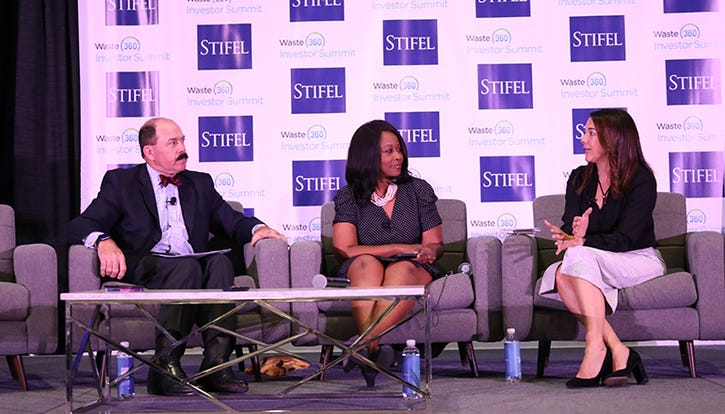
“One of the big myths is that we find these younger generations lazy,” explained Villa. “It’s not that millennials are lazy either, they just work differently.”
“I think another myth is that they want to transcend from assistant to CEO in six months,” added Oates-Forney. “Their careers are going to be lattices rather than ladders, meaning they are going to be doing a lot of side things. As a company, we have to make sure that we have the agility to help them work that way.”
“Gen Z is very different from millennials,” said Villa. “They want to work for a large company that has been around for a long time. They saw their parents struggle through the [Great] Recession and they do not want those same challenges. We call them the throwback generation in our facility, or the silent generation.”
Oates-Forney added that quick turnaround on a company’s application process also is key for younger generations. “If the application process online takes more than 10 minutes, they are not going to do it,” she said.
Chatting with Waste Management’s CFO and COO
When Hoffman asked Waste Management CFO Devina Rankin and Chief Operating Officer (COO) John Morris about the perception of the company as the largest player in collection and recycling, Morris said the 43,000 people who work for Waste Management are key.
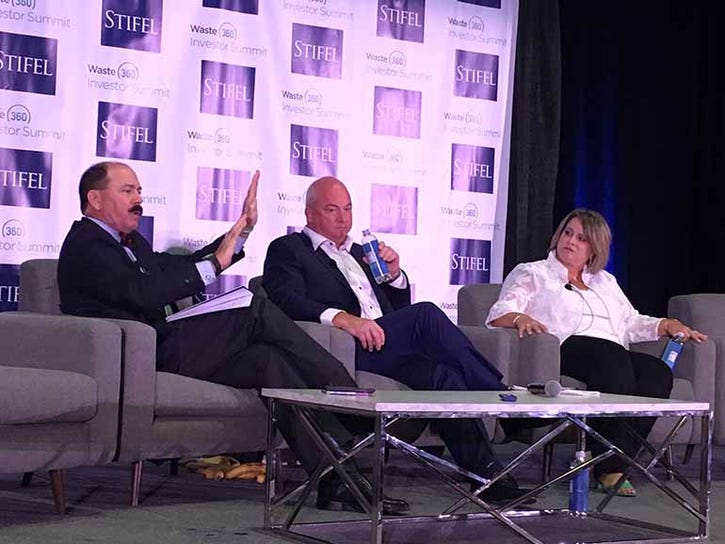
Rankin added that WM has been sharply focused on growing revenue and operating more efficiently. “I think it comes from discipline and execution,” she said. “The organization is thinking about the data that we now collect on onboard units to create efficiency in this business that we haven’t been able to create in the past. Our top priority is being a great place to work and a great place to serve customers.”
Due to the crunched labor market in the waste and recycling industry, Morris also emphasized that potential employees have a lot of options as to where to work throughout the industry.
“We feel like we’re competing against a lot of other folks,” he explained. “We watch turnover, we watch when employees leave, why they leave and how long they stay. We have been starting to focus more on why people are staying now and looking at how to replicate that, and leadership is big. I’m not sure that was always as important 10 years ago as it is today, but it needs to be.”
Morris also noted that maintenance expenses have been a bit of a headwind for WM, so the company is focusing its efforts there right now. Rankin added that the company is continuing its transition to a fleet of compressed natural gas (CNG) vehicles to reduce fuel and maintenance costs. However, she noted, that many new trucks haven’t been delivered as expected, which makes operations and leveraging data from the trucks more challenging. Rankin also added that labor and the demand for truck technicians in the business is at an all-time high.
Hoffman then asked Rankin and Morris to share what they could of the ongoing Advanced Disposal acquisition.
“We always target deals where the whole will be greater than the sum of its parts,” explained Rankin. “We think there will be great synergy benefits here, and we are looking forward to bringing these companies together and serving 3 million more customers.”
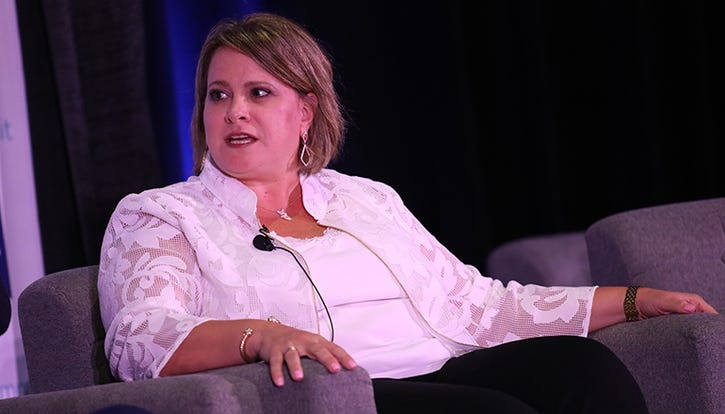
Casella Talks Contamination, Boston Contract
Casella CEO John Casella, COO Ed Johnson and Finance Director Jason Mead presented during the annual Investor Summit. Casella pointed out that economic activity has been good across the Northeast, which has helped drive pricing. Casella pricing has been further helped by a tight disposal market in the Northeast, which is expected to continue to tighten for the foreseeable future.
On the recycling side of the business, Casella noted that the company’s SRA fee continues to be successful in offsetting reduced recycled commodity pricing. Contamination levels are between 15 and 18 percent on volumes coming to the materials recovery facility (MRF). The company has added contamination surcharges to some customers and increased education efforts to reduce contamination levels.
Casella said the company needs to get contamination levels down to a 4 to 6 percent level coming into the MRF. He also discussed the Boston recycling contract, which has protections on declining commodity prices but does offer to share the upside if commodity prices recover. The Boston bid also includes incentives for the city to reduce contamination levels, noted Casella.
GFL Environmental Addresses Canadian Market
GFL Environmental, the largest private U.S. waste company with operations in both the U.S. and Canada, generates annual revenue and EBITDA of $2.3 billion and $800 million, respectively. During the summit, Patrick Dovigi, CEO of GFL Environmental Inc., highlighted what is going on with the company’s liquid waste business and Canadian business.
GFL liquid waste customers are larger industrial businesses, including oil and gas and manufacturing. Dovigi explained that a big part of this segment is used motor oil, which GFL is a collector and aggregator. He added that GFL collects around 40 million gallons of liquid waste in the U.S. and 35 million gallons in Canada.
GFL operates in nine of the 10 providences in Canada. Dovigi noted that the Canadian market looks healthy overall, with Canadian EBITDA margins around the high 20 percent level, with solid cash flow generation.
On its recycling side of business, GFL has four Canadian MRFs and collection/service exposure in Michigan. Dovigi said GFL is working to renegotiate its Michigan contracts to match changes in recycling markets.
NWRA and ISRI on Recycled Commodity Markets
During an afternoon discussion titled “The Future of Recycled Commodity Markets,” panelists Joseph C. Pickard, chief economist and director of commodities for the Institute of Scrap Recycling Industries (ISRI) and Anne M. Germain, technical and regulatory vice president for the National Waste & Recycling Association (NWRA), joined Hoffman to discuss scrap metal markets and recycling contracts trends.
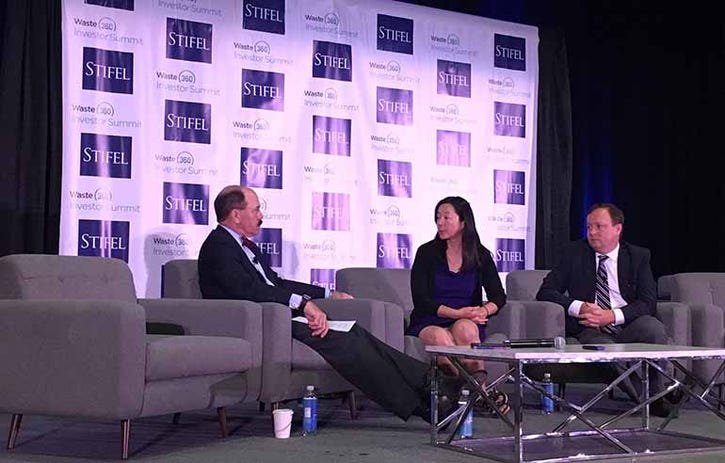
Highlights from their discussion include:
Germain noted that the U.S. remains the biggest market for scrap metals and that tariffs have pushed increased U.S. steel production, which uses a lot of recycled ferrous scrap metals and has been a positive for scrap. China has not had the biggest impact of ferrous scrap as it is not the largest export destination of U.S. ferrous scrap. The big drivers of the aluminum market are transportation and construction industries.
The market is seeing a shift to “fee for service” model, with municipalities and customers taking more/most of the commodity price exposure. In addition, the market has seen a long-term shift from “true” recycling (value from used commodities) to diversion (not sending material to landfill first). Even at higher recycling costs, there remains demand for recycling as it is viewed as the “right thing to do,” noted Germain.
Contamination continues to be an issue for the recycled commodity stream for both domestic and export volumes. “Contamination is an issue in ISRI membership, and China has been driving that,” noted Pickard. “On the contamination side for us, China accelerated the focus on reducing contamination in the loads we’re shipping overseas. But improving the quality, whether you’re shipping overseas or to a domestic consumer, is going to be the name of the game.”
NWRA is working to reduce contamination levels by providing a more simplified list of recycled materials and increased education efforts on what is recyclable. The market also is changing contracts to limit loads of contamination levels or charge a fee for higher contamination levels. There also are efforts to work with manufacturers to improve the ability of packaging and products to be more easily recycled, particularly amid the Amazon effect and in the era of e-commerce.
Republic Services Discusses Recycling Market, Technology
During the summit, Republic Services CEO Don Slager, CFO Chuck Serianni, COO Jon Vander Ark and Chief Development Officer Brian Bales took the stage to discuss the company’s focus on recycling market and technology.
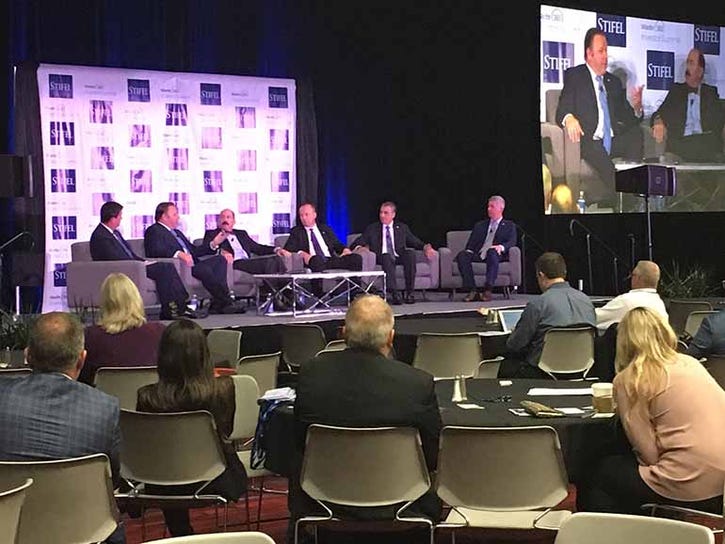
Here are some of the key points from that session:
The company has put a great deal of focus on its people and human resources, noted Slager. Republic said it has worked hard on building out the team with a strong bench at the executive vice president levels as well as several levels down the organization chart with a big focus on cross training.
Republic also referred to recycling as “broken” but with chances for long-term opportunity. Slager said the current recycling model is broken, but Republic remains bullish on the long-term prospect of recycling. The company’s focus is on modifying its contracts to fix the business in the near term and position the business for the long term. And if the customer is willing to pay for recycling services at a level that makes this a viable business.
The company is focused on using technology to better service and interact with customers, including implementing new technology in vehicles and working with drivers to best implement the changes. The company is in the early innings of this vehicle technology roll out process.
Slager noted that the company is pushing vehicle manufacturers to provide more safety technology in new collection vehicles. Also working with vendors to put a new Mack electric truck on the street servicing customers. Republic said it is continuing to replace and roll out CNG vehicles in markets that request it but is not focused on actively expanding its CNG fleet.
Regarding acquisitions, Republic said it is looking at “environmental services” acquisitions that include E&P waste and industrial waste opportunities.
About the Author
You May Also Like




